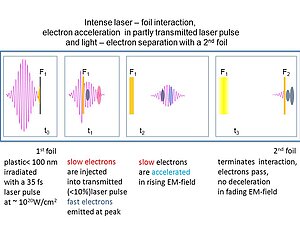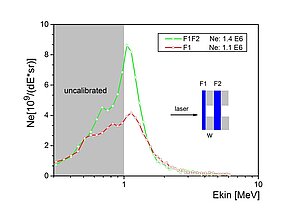Fig. 1b: Electrons detected in the laser propagation direction of a single (F1) and double-foil target (F1F2), in which the second foil acts as a separator. The plastic films used have a layer thickness of F1 = 35 nm and F2 = 85 nm. Ne indicates the integrated number of electrons for the entire detection range (0.2-7.5 MeV) with respect to the spectrometer aperture.
For sufficiently low film thicknesses below 100 nm, a part of the laser light can pass through this plasma and thereby the electrons already emitted behind the film are overtaken by the transmitted light pulse. Quasi intrinsically synchronized, the "slow" electrons are injected into the transmitted, still relativistic laser field (<8 x 1018W / cm2). Now, if a second thin film is placed as a separator at a suitable distance behind the first film, an amplification of the electron signal can be found in a very specific energy range. Figure 1a schematically shows the time course in the experiment and Figure 1b compares the resulting electron distribution obtained with and without additional separator foil. The separator film is impermeable to the transmitted laser light but permeable to the fast electrons, therefore the electrons can be decoupled from the light field. The point in time at which the interaction of the electrons with the transmitted laser pulse is interrupted is predetermined by the distance between the films.
The experiments carried out in the group of Matthias Schnürer show that the amplification of the electron signal becomes maximal at a certain distance and completely disappears for very large distances. The theoretical concept of leaving electrons at high kinetic energies by timely decoupling from the laser pulse after acceleration has been confirmed by numerous series of measurements and numerical simulations. The experiments and the analytical model show that slow electrons with kinetic energies below 100 keV are accelerated to an order of magnitude higher energy by the presence of the second foil. This effect leads to a compression of the electrons in a narrow energy range. Unlike the so-called "keel wave acceleration", which has already demonstrated the generation of GeV electrons with a laser-driven plasma wave, the direct laser acceleration can be scaled to very high laser intensities and plasma densities. In addition to fundamental physical insights, future applications in the field of laser-based sources of relativistic electrons are therefore based on this concept.

